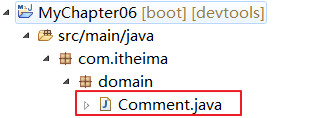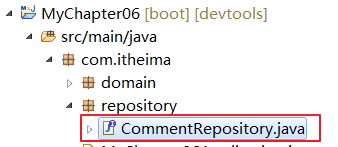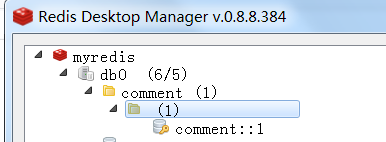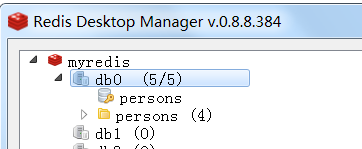缓存是分布式系统中的重要组件,主要解决数据库数据的高并发访问。在实际开发中,尤其是用户访问量较大的网站,用户对高频热点数据的访问非常频繁,为了提高服务器访问性能、减少数据库的压力、提高用户体验,使用缓存显得尤为重要。
一、基础环境搭建
1.准备数据,创建项目
这里使用之前创建的springbootdata的数据库,该数据库有两个表t_article和t_comment,这两个表预先插入几条测试数据。
使用Spring starter project方式创建一个Spring Boot项目,选择JPA依赖、MySQL依赖和Web依赖,如下图

2.编写数据库表对应的实体类

@Entity(name = "t_comment")
public class Comment {
@Id
@GeneratedValue(strategy = GenerationType.IDENTITY)
private Integer id;
private String content;
private String author;
@Column(name = "a_id")
private Integer aId;
//补充get set toString
}3.编写数据库操作的Repository接口文件CommentRepository

public interface CommentRepository extends JpaRepository<Comment,Integer>{
@Transactional
@Modifying
@Query("UPDATE t_comment c SET c.author= ?1 WHERE c.id = ?2")
public int updateComment(String author,Integer id);
}4.编写业务操作类Service文件CommentService
在该类中编写数据的查询、修改和删除操作
@Service
public class CommentService {
@Autowired
private CommentRepository commentRepository;
public Comment findById(int comment_id){
Optional<Comment> optional = commentRepository.findById(comment_id);
if(optional.isPresent()){
return optional.get();
}
return null;
}
public Comment updateComment(Comment comment){
commentRepository.updateComment(comment.getAuthor(), comment.getId());
return comment;
}
public void deleteComment(int comment_id){
commentRepository.deleteById(comment_id);
}
}5.编写表示层的控制器CommentController
使用注入的CommentService实例对象编写对Comment评论数据的查询、修改和删除方法。
@RestController
public class CommentController {
@Autowired
private CommentService commentService;
@GetMapping("/get/{id}")
public Comment findById(@PathVariable("id") int comment_id) {
Comment comment = commentService.findById(comment_id);
return comment;
}
@GetMapping("/update/{id}/{author}")
public Comment updateComment(@PathVariable("id") int comment_id, @PathVariable("author") String author) {
Comment comment = commentService.findById(comment_id);
comment.setAuthor(author);
Comment updateComment = commentService.updateComment(comment);
return updateComment;
}
@GetMapping("/delete/{id}")
public void deleteComment(@PathVariable("id") int comment_id) {
commentService.deleteComment(comment_id);
}
}6.编写配置文件
spring.datasource.url=jdbc:mysql://localhost:3306/springbootdata?serverTimezone=UTC
spring.datasource.username=root
spring.datasource.password=root
spring.jpa.show-sql=true7.项目测试
项目启动成功后,在浏览器上访问http://localhost:8080/get/1,浏览器每刷新一次,控制台会新输出一条SQL语句


每执行一次查询操作,都会访问一次数据库并执行一次SQL语句。
二、Spring Boot 默认缓存体验
1、启动类上添加@EnableCaching注解
开启基于注解的缓存支持
//启动类
@EnableCaching
@SpringBootApplication
public class Chapter06Application {
public static void main(String[] args) {
SpringApplication.run(Chapter06Application.class, args);
}
}2.使用@Cacheable注解对数据操作方法进行缓存管理
//业务层
@Cacheable(cacheNames = "comment")
public Comment findById(int comment_id){
Optional<Comment> optional = commentRepository.findById(comment_id);
if(optional.isPresent()){
return optional.get();
}
return null;
}3.Spring Boot默认缓存测试
项目启动成功后,在浏览器上访问http://localhost:8080/get/1,不论浏览器刷新多少次,页面的查询结果都会显示同一条数据


重复进行同样的查询操作,数据库只执行了一次SQL查询语句,说明项目开启的默认缓存支持已经生效。
4、测试发生一万次请求需要的时间,jdk11以上
import java.net.URI;
import java.net.http.HttpClient;
import java.net.http.HttpRequest;
import java.net.http.HttpResponse;
import java.time.Duration;
import java.util.concurrent.CompletableFuture;
import java.util.concurrent.TimeUnit;
import java.util.stream.Collectors;
import java.util.stream.IntStream;
public class HttpRequestBenchmark {
public static void main(String[] args) throws Exception {
String url = "http://localhost:8081/get/1"; // 替换为你要请求的URL
int numRequests = 10000; // 请求次数
HttpClient client = HttpClient.newHttpClient();
HttpRequest request = HttpRequest.newBuilder()
.uri(new URI(url))
.build();
long startTime = System.nanoTime();
// 使用CompletableFuture来异步发送请求,并等待所有请求完成
CompletableFuture<Void>[] futures = IntStream.range(0, numRequests)
.mapToObj(i -> CompletableFuture.runAsync(() -> {
try {
HttpResponse<String> response = client.send(request, HttpResponse.BodyHandlers.ofString());
// 在这里可以处理响应,例如检查状态码等
System.out.println("xiangying------------------");
// 这里只是简单发送请求并忽略响应内容
} catch (Exception e) {
e.printStackTrace();
}
}))
.toArray(CompletableFuture[]::new);
// 等待所有请求完成
CompletableFuture.allOf(futures).join();
long endTime = System.nanoTime();
Duration duration = Duration.ofNanos(endTime - startTime);
System.out.println("发送" + numRequests + "次HTTP请求需要的时间:" + duration.toMillis() + "毫秒");
}
三、Spring Boot 缓存注解介绍
1.@EnableCaching注解
@EnableCaching是由Spring框架提供的,Spring Boot框架对该注解进行了继承,该注解需要配置在类上(在Spring Boot中,通常配置在项目启动类上),用于开启基于注解的缓存支持。
2.@Cacheable注解
@Cacheable注解也是由Spring框架提供的,可以作用于类或方法(通常用在数据查询方法上),用于对方法结果进行缓存存储。
@Cacheable注解的执行顺序是,先进行缓存查询,如果为空则进行方法查询,并将结果进行缓存;如果缓存中有数据,不进行方法查询,而是直接使用缓存数据。
| 属性名 | 说明 |
| value/cacheNames | 指定缓存空间的名称,必配属性。这两个属性二选一使用 |
| key | 指定缓存数据的key,默认使用方法参数值,可以使用SpEL表达式 |
| keyGenerator | 指定缓存数据的key的生成器,与key属性二选一使用 |
| cacheManager | 指定缓存管理器 |
| cacheResolver | 指定缓存解析器,与cacheManager属性二选一使用 |
| condition | 指定在符合某条件下,进行数据缓存 |
| unless | 指定在符合某条件下,不进行数据缓存 |
| sync | 指定是否使用异步缓存。默认false |
3.@CachePut注解
@CachePut注解是由Spring框架提供的,可以作用于类或方法(通常用在数据更新方法上),该注解的作用是更新缓存数据。@CachePut注解的执行顺序是,先进行方法调用,然后将方法结果更新到缓存中。
@CachePut注解也提供了多个属性,这些属性与@Cacheable注解的属性完全相同。
4.@CacheEvict注解
@CacheEvict注解是由Spring框架提供的,可以作用于类或方法(通常用在数据删除方法上),该注解的作用是删除缓存数据。@CacheEvict注解的默认执行顺序是,先进行方法调用,然后将缓存进行清除。
@CacheEvict注解也提供了多个属性,这些属性与@Cacheable注解的属性基本相同,除此之外,还额外提供了两个特殊属性allEntries和beforeInvocation。
@CacheEvict注解的特殊属性
(1)allEntries属性
allEntries属性表示是否清除指定缓存空间中的所有缓存数据,默认值为false(即默认只删除指定key对应的缓存数据)。
(2)beforeInvocation属性
beforeInvocation属性表示是否在方法执行之前进行缓存清除,默认值为false(即默认在执行方法后再进行缓存清除)。
5.@Caching注解
@Caching注解用于针对复杂规则的数据缓存管理,可以作用于类或方法,在@Caching注解内部包含有Cacheable、put和evict三个属性,分别对应于@Cacheable、@CachePut和@CacheEvict三个注解。
@Caching(cacheable={@Cacheable(cacheNames ="comment",key = "#id")},
put = {@CachePut(cacheNames = "comment",key = "#result.author")})
public Comment getComment(int comment_id){
return commentRepository.findById(comment_id).get();
}
6.@CacheConfig注解
@CacheConfig注解使用在类上,主要用于统筹管理类中所有使用@Cacheable、@CachePut和@CacheEvict注解标注方法中的公共属性,这些公共属性包括有cacheNames、keyGenerator、cacheManager和cacheResolver。
@CacheConfig(cacheNames = "comment")
@Service
public class CommentService {
@Autowired
private CommentRepository commentRepository;
@Cacheable
public Comment findById(int comment_id){
Comment comment = commentRepository.findById(comment_id).get();
return comment; }...}四、Spring Boot支持的缓存组件
(1)Generic
(2)JCache (JSR-107) (EhCache 3、Hazelcast、Infinispan等)
(3)EhCache 2.x
(4)Hazelcast
(5)Infinispan
(6)Couchbase
(7)Redis
(8)Caffeine
(9)Simple(默认)
开启缓存管理后,springboot会按照上述列表顺序查找有效的缓存组件进行缓存管理。
五、基于注解的Redis缓存实现
1.添加Spring Data Redis 依赖启动器
<dependency>
<groupId>org.springframework.boot</groupId>
<artifactId>spring-boot-starter-data-redis</artifactId>
</dependency>如果查不到缓存,重启项目或updateproject下,有可能没有下载这个依赖
2.Redis服务连接配置
服务器顺便开启下,省得待会忘了
spring.redis.host=127.0.0.1
spring.redis.port=6379
spring.redis.password=3.使用@Cacheable、@CachePut、@CacheEvict注解定制缓存管理
对CommentService类中的方法进行修改使用@Cacheable、@CachePut、@CacheEvict三个注解定制缓存管理,修改后的方法如下
@Cacheable(cacheNames = "comment",unless = "#result==null")
public Comment findById(int comment_id){
Optional<Comment> optional = commentRepository.findById(comment_id);
if(optional.isPresent()){
return optional.get();
}
return null;
}
@CachePut(cacheNames = "comment",key = "#result.id")
public Comment updateComment(Comment comment){
commentRepository.updateComment(comment.getAuthor(), comment.getId());
return comment;
}
@CacheEvict(cacheNames = "comment")
public void deleteComment(int comment_id){
commentRepository.deleteById(comment_id);
}4.基于注解的Redis查询缓存测试
项目启动成功后,通过浏览器访问http://localhost:8080/get/1,如果是热部署,可能不成功,需要关闭项目再重启
控制台显示如下:
。。。。
Hibernate: select comment0_.id as id1_0_0_, comment0_.a_id as a_id2_0_0_, comment0_.author as author3_0_0_, commen。。。。
。。。。
java.lang.IllegalArgumentException: DefaultSerializer requires a Serializable payload but received an object of type [com.itheima.my06.entity.Comment]
。。。。
出现非法参数异常,需要对实体类进行序列化
public class Comment implements Serializable {
再次做基于注解的Redis缓存查询测试
项目启动成功后,通过浏览器访问http://localhost:8080/get/1,并重复刷新浏览器,只出现一条sql语句


打开Redis客户端可视化管理工具Redis Desktop Manager,连接本地启用的Redis服务

可以看出,评论存储到了redis缓存库中comment名称空间下,key=comment::1,value=经过JDK默认序列化格式后的HEX格式值,不方便查看,需要自定义数据的序列化格式。
5.基于注解的Redis缓存更新测试
项目启动成功后,通过浏览器访问http://localhost:8080/update/1/shitou,接着,继续访问http://localhost:8080/get/1



执行updateComment()方法更新id为1的数据时执行了一条更新SQL语句,后续调用findById()方法查询id为1的用户评论信息时没有执行查询SQL语句。

6.基于注解的Redis缓存删除测试
项目启动成功后,通过Redis客户端可视化管理工具Redis Desktop Manager查看缓存信息。
如果不存在,通过浏览器访问http://localhost:8080/get/1,缓存数据,
再次通过Redis Desktop Manager查看,reload下


接着访问http://localhost:8080/delete/1,
reload,查看缓存信息,该条缓存被删除


六、基于API的Redis缓存实现
1.使用Redis API 进行业务数据缓存管理
编写一个进行业务处理的类ApiCommentService,使用@Autowired注解注入Redis API中常用的RedisTemplate(类似于Java基础API中的JdbcTemplate);
然后在数据查询、修改和删除三个方法中,根据业务需求分别进行数据缓存查询、缓存存储、缓存更新和缓存删除。
同时,Comment数据对应缓存管理的key值都手动设置了一个前缀“comment_”,这是针对不同业务数据进行缓存管理设置的唯一key,避免与其他业务缓存数据的key重复。
@Service
public class ApiCommentService {
@Autowired
private CommentRepository commentRepository;
@Autowired
private RedisTemplate redisTemplate;
public Comment findById(int comment_id){
// 先从Redis缓存中查询数据
Object object = redisTemplate.opsForValue().get("comment_"+comment_id);
if (object!=null){
return (Comment)object;
}else {
// 缓存中没有,就进入数据库查询
Optional<Comment> optional = commentRepository.findById(comment_id);
if(optional.isPresent()){
Comment comment= optional.get();
// 将查询结果进行缓存,并设置有效期为1天
redisTemplate.opsForValue().set("comment_"+comment_id, comment,1, TimeUnit.DAYS);
return comment;
}else {
return null;
}
}
}
public Comment updateComment(Comment comment){
commentRepository.updateComment(comment.getAuthor(), comment.getId());
// 更新数据后进行缓存更新
redisTemplate.opsForValue().set("comment_"+comment.getId(),comment);
return comment;
}
public void deleteComment(int comment_id){
commentRepository.deleteById(comment_id);
// 删除数据后进行缓存删除
redisTemplate.delete("comment_"+comment_id);
}
}2.创建Web访问层类ApiCommentController
在类上加入了@RequestMapping(“/api”)注解用于窄化请求,
并通过@Autowired注解注入了新编写的ApiCommentService实例对象,
然后调用ApiCommentService中的相关方法进行数据查询、修改和删除。
@RestController
@RequestMapping("/api") // 窄化请求路径
public class ApiCommentController {
@Autowired
private ApiCommentService apiCommentService;
@GetMapping("/get/{id}")
public Comment findById(@PathVariable("id") int comment_id){
Comment comment = apiCommentService.findById(comment_id);
return comment;
}
@GetMapping("/update/{id}/{author}")
public Comment updateComment(@PathVariable("id") int comment_id,
@PathVariable("author") String author){
Comment comment = apiCommentService.findById(comment_id);
comment.setAuthor(author);
Comment updateComment = apiCommentService.updateComment(comment);
return updateComment;
}
@GetMapping("/delete/{id}")
public void deleteComment(@PathVariable("id") int comment_id){
apiCommentService.deleteComment(comment_id);
}
}3.基于API的Redis缓存实现的相关配置
- 基于API的Redis缓存实现不需要@EnableCaching注解开启基于注解的缓存支持。
- 基于API的Redis缓存实现需要在Spring Boot项目的pom.xml文件中引入Redis依赖启动器,并在配置文件中进行Redis服务连接配置,同时将进行数据存储的Comment实体类实现序列化接口。
- 缓存测试与基于注解的Redis缓存实现的测试基本一样,但访问路径加“/api”,如http://localhost:8080/api/get/2
4.做测试
http://localhost:8080/api/get/1

jdk序列化导致出现上图红色框的内容,无意义但会占据内存,所以要更改序列化方式
七、通过RedisTemplate自定义缓存序列化(通过api缓存数据)
1.Redis API 默认序列化机制
基于Redis API的Redis缓存实现是使用RedisTemplate模板进行数据缓存操作的,这里打开RedisTemplate类,查看源码可知:
@Override
public void afterPropertiesSet() {
super.afterPropertiesSet();
boolean defaultUsed = false;
if (defaultSerializer == null) {
defaultSerializer = new JdkSerializationRedisSerializer(
classLoader != null ? classLoader : this.getClass().getClassLoader());
}1.使用RedisTemplate进行Redis数据缓存操作时,内部默认使用的是JdkSerializationRedisSerializer序列化方式,所以进行数据缓存的实体类必须实现JDK自带的序列化接口(例如Serializable);
2.使用RedisTemplate进行Redis数据缓存操作时,如果自定义了缓存序列化方式defaultSerializer,那么将使用自定义的序列化方式。
2.自定义RedisTemplate序列化机制
分析:
在项目中引入Redis依赖后,Spring Boot提供的RedisAutoConfiguration自动配置会生效。
打开RedisAutoConfiguration类,查看内部源码中关于RedisTemplate的定义方式可知:
public class RedisAutoConfiguration {
@Bean
@ConditionalOnMissingBean(name = "redisTemplate")
public RedisTemplate<Object, Object> redisTemplate(RedisConnectionFactory redisConnectionFactory) throws UnknownHostException {
RedisTemplate<Object, Object> template = new RedisTemplate<>();
template.setConnectionFactory(redisConnectionFactory);
return template;
}- 在Redis自动配置类中,通过Redis连接工厂RedisConnectionFactory初始化了一个RedisTemplate;该类上方添加了@ConditionalOnMissingBean注解(顾名思义,当某个Bean不存在时生效),用来表明如果开发者自定义了一个名为redisTemplate的Bean,则该默认初始化的RedisTemplate会被覆盖。
- 如果想要使用自定义序列化方式的RedisTemplate进行数据缓存操作,可以参考上述核心代码创建一个名为redisTemplate的Bean组件,并在该组件中设置对应的序列化方式即可。
解决:
在项目中创建一个Redis自定义配置类RedisConfig,通过@Configuration注解定义了一个RedisConfig配置类,并使用@Bean注解注入了一个默认名称为方法名的redisTemplate组件(注意,该Bean组件名称必须是redisTemplate)。在定义的Bean组件中,自定义了一个RedisTemplate,使用自定义的Jackson2JsonRedisSerializer数据序列化方式;在定制序列化方式中,定义了一个ObjectMapper用于进行数据转换设置。
@Configuration // 定义一个配置类
public class RedisConfig {
@Bean
public RedisTemplate<Object, Object> redisTemplate(RedisConnectionFactory redisConnectionFactory) {
RedisTemplate<Object, Object> template = new RedisTemplate();
template.setConnectionFactory(redisConnectionFactory);
// 使用JSON格式序列化对象,对缓存数据key和value进行转换
Jackson2JsonRedisSerializer jacksonSeial = new Jackson2JsonRedisSerializer(Object.class);
// 解决查询缓存转换异常的问题
ObjectMapper om = new ObjectMapper();
om.setVisibility(PropertyAccessor.ALL, JsonAutoDetect.Visibility.ANY);
//过时om.enableDefaultTyping(ObjectMapper.DefaultTyping.NON_FINAL);
//用下面的方法代替上面的方法
om.activateDefaultTyping(LaissezFaireSubTypeValidator.instance,ObjectMapper.DefaultTyping.NON_FINAL);
jacksonSeial.setObjectMapper(om);
// 设置RedisTemplate模板API的序列化方式为JSON
template.setDefaultSerializer(jacksonSeial);
//设置key的序列化器
template.setKeySerializer(new StringRedisSerializer());
return template;
}
}3.效果测试
项目启动成功后,通过浏览器访问http://localhost:8080/api/get/3,并重复刷新浏览器查看同一条数据信息 ,数据库只执行了一次SQL语句


八、通过RedisCacheManager自定义缓存序列化(适用通过注解缓存数据)
1.Redis 注解默认序列化机制
1.Spring Boot整合Redis组件提供的缓存自动配置类RedisCacheConfiguration(org.springframework.boot.autoconfigure.cache),
其内部是通过Redis连接工厂RedisConnectionFactory定义了一个缓存管理器RedisCacheManager;
同时定义RedisCacheManager时,也默认使用了JdkSerializationRedisSerializer序列化方式。
@Configuration(proxyBeanMethods = false)
@ConditionalOnClass(RedisConnectionFactory.class)
@AutoConfigureAfter(RedisAutoConfiguration.class)
@ConditionalOnBean(RedisConnectionFactory.class)
@ConditionalOnMissingBean(CacheManager.class)
@Conditional(CacheCondition.class)
class RedisCacheConfiguration {
@Bean
RedisCacheManager cacheManager(CacheProperties cacheProperties, CacheManagerCustomizers cacheManagerCustomizers,
ObjectProvider<org.springframework.data.redis.cache.RedisCacheConfiguration> redisCacheConfiguration,
ObjectProvider<RedisCacheManagerBuilderCustomizer> redisCacheManagerBuilderCustomizers,
RedisConnectionFactory redisConnectionFactory, ResourceLoader resourceLoader) {
RedisCacheManagerBuilder builder = RedisCacheManager.builder(redisConnectionFactory).cacheDefaults(
determineConfiguration(cacheProperties, redisCacheConfiguration, resourceLoader.getClassLoader()));
List<String> cacheNames = cacheProperties.getCacheNames();
if (!cacheNames.isEmpty()) {
builder.initialCacheNames(new LinkedHashSet<>(cacheNames));
}
if (cacheProperties.getRedis().isEnableStatistics()) {
builder.enableStatistics();
}
redisCacheManagerBuilderCustomizers.orderedStream().forEach((customizer) -> customizer.customize(builder));
return cacheManagerCustomizers.customize(builder.build());
}
private org.springframework.data.redis.cache.RedisCacheConfiguration determineConfiguration(
CacheProperties cacheProperties,
ObjectProvider<org.springframework.data.redis.cache.RedisCacheConfiguration> redisCacheConfiguration,
ClassLoader classLoader) {
return redisCacheConfiguration.getIfAvailable(() -> createConfiguration(cacheProperties, classLoader));
}
private org.springframework.data.redis.cache.RedisCacheConfiguration createConfiguration(
CacheProperties cacheProperties, ClassLoader classLoader) {
Redis redisProperties = cacheProperties.getRedis();
org.springframework.data.redis.cache.RedisCacheConfiguration config = org.springframework.data.redis.cache.RedisCacheConfiguration
.defaultCacheConfig();
config = config.serializeValuesWith(
SerializationPair.fromSerializer(new JdkSerializationRedisSerializer(classLoader)));
if (redisProperties.getTimeToLive() != null) {
config = config.entryTtl(redisProperties.getTimeToLive());
}
if (redisProperties.getKeyPrefix() != null) {
config = config.prefixCacheNameWith(redisProperties.getKeyPrefix());
}
if (!redisProperties.isCacheNullValues()) {
config = config.disableCachingNullValues();
}
if (!redisProperties.isUseKeyPrefix()) {
config = config.disableKeyPrefix();
}
return config;
}
}2.如果想要使用自定义序列化方式的RedisCacheManager进行数据缓存操作,可以创建一个名为cacheManager的Bean组件,并在该组件中设置对应的序列化方式即可
2.自定义RedisCacheManager
@Bean
public RedisCacheManager cacheManager(RedisConnectionFactory redisConnectionFactory) {
// 分别创建String和JSON格式序列化对象,对缓存数据key和value进行转换
RedisSerializer<String>strSerializer = new StringRedisSerializer();
Jackson2JsonRedisSerializer jacksonSeial = new Jackson2JsonRedisSerializer(Object.class);
// 解决查询缓存转换异常的问题
ObjectMapper om = new ObjectMapper();
om.setVisibility(PropertyAccessor.ALL, JsonAutoDetect.Visibility.ANY);
//过时om.enableDefaultTyping(ObjectMapper.DefaultTyping.NON_FINAL);
//用下面的方法代替上面的方法
om.activateDefaultTyping(LaissezFaireSubTypeValidator.instance,ObjectMapper.DefaultTyping.NON_FINAL);
jacksonSeial.setObjectMapper(om);
// 定制缓存数据序列化方式及时效
RedisCacheConfiguration config = RedisCacheConfiguration.defaultCacheConfig()
.entryTtl(Duration.ofDays(1))
.serializeKeysWith(RedisSerializationContext.SerializationPair.fromSerializer(strSerializer))
.serializeValuesWith(RedisSerializationContext.SerializationPair.fromSerializer(jacksonSeial))
.disableCachingNullValues();
RedisCacheManager cacheManager = RedisCacheManager.builder(redisConnectionFactory).cacheDefaults(config).build();
return cacheManager;
}3.效果测试
项目启动成功后,通过浏览器访问http://localhost:8080/get/3,并重复刷新浏览器查看同一条数据信息 ,数据库只执行了一次SQL语句

缓存结果如下:























 3590
3590











 被折叠的 条评论
为什么被折叠?
被折叠的 条评论
为什么被折叠?








